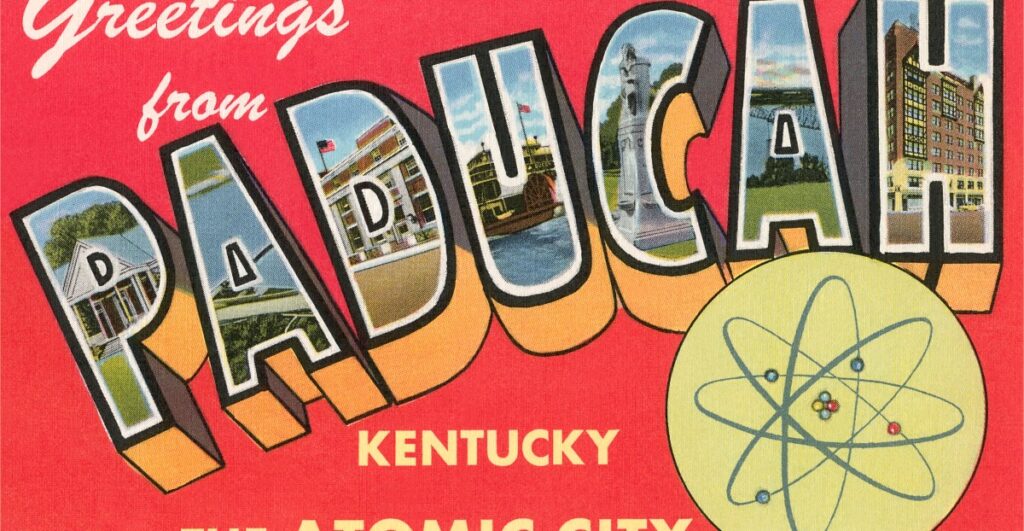
These days, Paducah, Kentucky — population 27,000 and home to the National Quilt Museum — prides itself as “Quilt City.” But decades ago, it was also called the “Atomic City” — a moniker it could soon regain as AI’s energy needs bring Paducah’s nuclear past back to life.
The Department of Energy (DOE) operated a uranium enrichment plant in Paducah for more than 60 years until the plant shuttered in 2013 amid a downturn in nuclear energy. The same year, Paducah was designated a UNESCO “creative city” for its quilts, a title it now boasts on its website (along with a city-led initiative to make Paducah more “considerate and kind”).
Today, the enrichment facility is in the spotlight again after a Peter Thiel-backed startup announced plans to revive the shuttered plant. In July, Donald Trump’s administration also chose Paducah as one of four sites where it says it’ll partner with private companies to develop AI data centers and energy projects.
Big Tech — thirsty for enough electricity to power its AI ambitions — wants to make nuclear energy cool again. It’s all playing into the Trump administration’s plans to remake the US power grid without solar and wind power. If they manage to revitalize nuclear energy in America, the US is going to need more enriched uranium. And that supply chain could bring big changes to even small cities like Paducah.
Big Tech — thirsty for enough electricity to power its AI ambitions — wants to make nuclear energy cool again
General Matter emerged from stealth mode earlier this year, led by former SpaceX engineer Scott Nolan. Peter Thiel, who cofounded PayPal and the datamining company Palantir that’s selling software to the Trump administration to surveil people who migrate to the US, joined General Matter’s board. And Nolan stood in the Oval Office with Trump on May 23rd as he signed executive orders ostensibly aimed at ushering in “a nuclear energy renaissance.”
At an August 5th event in Paducah, General Matter shared details about its vision for the facility. It says it’ll develop what it considers the “the nation’s first U.S.-owned, privately developed uranium enrichment facility” on the site and that it has signed “a multi-decade, one hundred-acre lease” with the DOE. General Matter plans to start enriching uranium in Paducah by the end of the decade and “produce the fuel needed for the next generation of nuclear energy, central to America’s aspirations in AI, manufacturing, and other critical industries,” according to a statement on X. (A DOE press release says enrichment operations aren’t planned until 2034, however, and that construction is slated to start in 2026.)
That doesn’t quite answer some key questions about the company’s plans. (General Matter didn’t respond to several emails from The Verge.) Will the company rely on the same outdated technology the shuttered plant has always used or build something new? If it does plan to revamp the facility with modern technology, does it plan to produce the same kind of low-enriched uranium that America’s existing nuclear reactors run on, or does it think it can be one of the first plants to produce more highly enriched uranium (called HALEU) for advanced reactors? The answers to those questions will define how ambitious of a project this really is, and the impact it could have on power grids across the US. The recent DOE press release notes that General Matter is one of four companies the agency selected in October of last year to provide enrichment services for HALEU, although the DOE also announced plans to contract General Matter for low-enriched uranium in December.
Enrichment is just one step, and kind of a headache, in the nuclear supply chain. Uranium first has to be mined and milled. Naturally occurring uranium has low levels of the isotope U-235 that nuclear fission reactors split to release energy. The uranium has to be converted into gas and then enriched to about a 5 percent concentration of U-235 to make fuel for a traditional reactor. Following a boom in nuclear power plants built in the 1970s and 1980s, however, the industry lost ground to gas-fired power plants generating electricity at lower costs. Nuclear reactors and uranium enrichment plants shuttered across the US.
But now, the opposite is happening. Microsoft and Meta have inked deals over the past year to revive old reactors. Other tech giants, including Amazon and Google, have committed to supporting companies designing advanced reactors that are supposed to be smaller, easier, and cheaper to build — potentially solving many of the problems that have plagued the nuclear energy industry for years, if they can eventually prove that these technologies are going to be able to perform at commercial scale.
That’s all driving up demand for uranium enrichment, now seen as a significant bottleneck in the nuclear energy supply chain. General Matter isn’t the only operation seeking to enrich uranium in Paducah. The DOE has had a deal with another company called Global Laser Enrichment (GLE) since 2016 to sell it leftover tails, depleted uranium, from years of enrichment for nuclear weapons and reactors at the site. GLE has been developing a new way to enrich uranium using lasers that’s supposed to be efficient enough to re-enrich uranium tails so that they can be used to make fuel again. General Matter similarly plans to re-enrich depleted uranium tails in Paducah, according to the DOE press release, although we still don’t know what kind of technology it will use to do so.
Laser technology has yet to be used to enrich uranium at commercial scale. Over the past decade, there just wasn’t enough demand for more uranium enrichment capacity in the US to move forward, says Nima Ashkeboussi, vice president of government relations and communications at GLE. Then Russia — a major supplier for nuclear fuel globally — invaded Ukraine, and in 2024, and the US barred imports of uranium from Russia. GLE applied for a license in June to finally start re-enriching the depleted uranium tails at a site adjacent to the Paducah plant, and expects to hear back from the Nuclear Regulatory Commission in about 18 months.
If all goes well, GLE plans to have its facility up and running by 2030 so it can start making the low-enriched uranium traditionally used by existing nuclear reactors. If at least one of the advanced reactors makes it to commercial operation, Ashkeboussi says that’ll be a market signal that it can start producing more highly enriched uranium (called HALEU) that next-generation reactors need. For now, only Russia has the capability to commercially produce HALEU. But already, data centers and AI have been a major driver in reinvigorating nuclear energy, Ashkeboussi tells The Verge. “We see that as a huge growth potential,” he says.
Both the Biden and Trump administrations have worked toward onshoring the nuclear supply chain again. The US currently has the capacity to enrich about a third of the uranium its nuclear reactors need. For Joe Biden, nuclear energy supported US climate goals of slashing planet-heating pollution by transitioning away from fossil fuels in the power grid. Trump is sabotaging US climate commitments and renewable energy projects, but still says nuclear energy has a role to play when it comes to making sure US tech companies have enough electricity to dominate the AI market.
The plans for Paducah seem to fit neatly into the Trump administration’s vision for AI, which it released last month. In short, the plan includes fast-tracking the development of energy-hungry data centers in conjunction with primarily fossil fuel and nuclear power plants by limiting environmental reviews.
“It seems their mindset is construction and production at all costs.”
The rush to build, especially as the Trump administration simultaneously guts the Environmental Protection Agency and Nuclear Regulatory Commission, has raised some flags over how much oversight and community participation there will be with these new projects. “I don’t have any confidence in what the administration is doing to protect public health and safety. It seems their mindset is construction and production at all costs,” says Edwin Lyman, director of nuclear power safety at the Union of Concerned Scientists that has been critical of the environmental and security risks nuclear energy can pose.
Nuclear energy has been a divisive technology among people concerned about climate change and pollution. It’s a carbon pollution-free source of electricity. But uranium mining near the Grand Canyon has already sparked opposition from environmental advocates and the Havasupai Tribe over how it could affect nearby communities and the water sources on which they rely. And the federal government has yet to solve decades of wrangling over where to store radioactive waste from nuclear reactors.
Adding to those concerns, the Trump administration wants to build on federal lands and even repurpose polluted Superfund sites for all this infrastructure. The shuttered enrichment plant in Paducah itself is a Superfund site, which means it’s on a list of places so contaminated that the Environmental Protection Agency has stepped in to prioritize their cleanup. That legacy shows the pitfalls and hurdles that policymakers and companies will have to try to avoid if they want to bring nuclear energy back to small-town USA.
“Regardless of what’s happening with the Trump administration, this is a massively bipartisan undertaking regarding uranium enrichment. There is a lot of support for it right now. I think there’s a lot of momentum to really get it right,” says Rowen Price, senior policy advisor for nuclear energy at the nonprofit Third Way, which supports nuclear energy.
Local lawmakers, for their part, have shown optimism over Paducah potentially playing a pivotal role in the future of AI and energy in the US. General Matter’s $1.5 billion proposed project in Paducah is supposed to create 140 jobs, according to Kentucky Governor Andy Beshear (D-KY).
“Just a few years ago, the idea of Kentucky leading the next wave of nuclear energy development may have seemed ambitious,” Sen. Danny Carroll (R-KY) wrote in an op-ed in the Lexington Herald-Leader. “Paducah is again at the center of America’s nuclear future.”
 Latest World Breaking News Online News Portal
Latest World Breaking News Online News Portal






